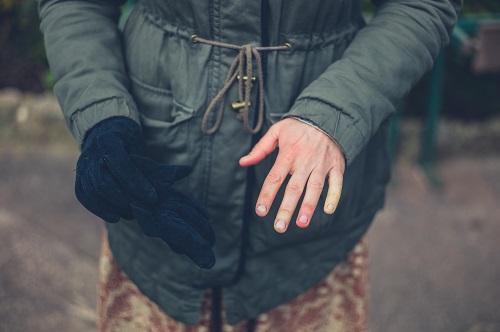Insights
Raynaud’s disease is a common condition that affects the blood supply to the extremities of your body when it’s cold. Your hands and feet are usually affected; the blood vessels in your fingers and toes contract, causing pain, numbness and colour changes.
Types of Raynaud’s
Raynaud’s affects up to ten million people in the UK. There are two types of this condition: Primary Raynaud’s and Secondary Raynaud’s. Primary Raynaud’s is the most common type and occurs by itself while Secondary Raynaud’s occurs from an underlying health condition, such as lupus or rheumatoid arthritis.
How to prevent a Raynaud’s attack
Although there is no cure for Raynaud’s, there are steps you can take to help prevent an attack:
Exercise regularly
Exercise can help to increase blood circulation and, in turn, may improve Raynaud’s. Even gentle exercise, such as walking, can help to get the blood flowing.
Avoid smoke
Smoking or inhaling second-hand smoke can cause Raynaud’s as smoke constricts the blood vessels, resulting in a drop in skin temperature.
Learn to manage stress
Stress, be it physical or emotional, can cause your blood vessels to constrict and trigger a Raynaud’s attack. Stress management is key to managing symptoms and preventing an attack.
Avoid sudden changes in temperature
Sudden temperature changes can provoke an attack, even if these changes are very mild. Wear layers as well as a hat, scarf and gloves to protect yourself from the cold and maintain a constant body temperature.
What causes Raynaud’s disease?
The exact cause of primary Raynaud’s is unknown. Raynaud’s disease affects women more than men and those who live in colder climates, but doctors do not know why some people suffer from the condition and some don’t.
However, secondary Raynaud’s, which is less common than primary Raynaud’s, can be caused by the following:
Associated diseases
Autoimmune diseases or connective tissue diseases are linked to secondary Raynaud’s. These conditions include:
- Blood disorders
- Buerger disease
- CREST syndrome
- Lupus
- Occlusive vascular disease
- Polymyositis
- Pulmonary hypertension
- Rheumatoid arthritis
- Scleroderma
- Sjögren's syndrome
Exposure to certain substances
Exposure to certain chemicals, such as vinyl chloride, can cause a scleroderma-like illness that’s linked to Raynaud’s.
Exposure to vibration from power tools
Workers who use vibrating tools or machinery on a regular basis can develop vibration-induced Raynaud’s disease, an early symptom of hand-arm vibration syndrome (HAVS). This is a repetitive strain injury (RSI) which causes tingling and numbness in the fingers.
HAV monitoring in the workplace will ensure that risks from vibration are adequately controlled and, in turn, prevent secondary Raynaud’s disease.
Choose Alcumus Sypol to control your workplace risks
Alcumus Sypol offers a range of workplace monitoring services so you can mitigate risks in your the workplace and demonstrate compliance. For further information, please call 01296 678 484.






